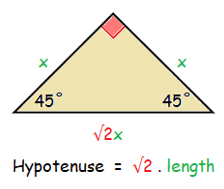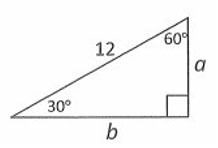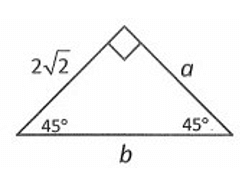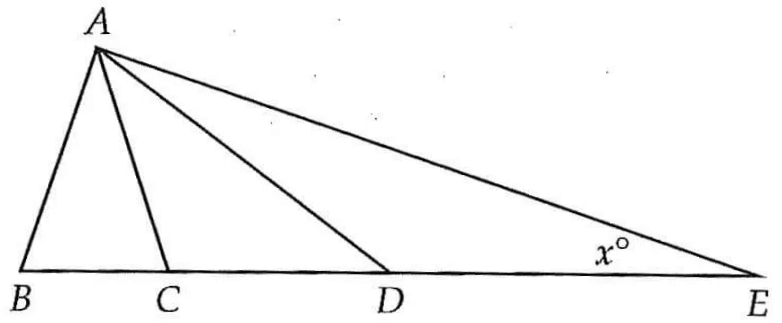PROBLEMS ON SPECIAL RIGHT TRIANGLES
Special right triangles are the triangles whose angle measures are
45° - 45° - 90° (or) 30° - 60° - 90°
45° - 45° - 90° triangle theorem :
In a 45° - 45° - 90° triangle, the hypotenuse is √2 times as long as each length.

30˚- 60˚- 90˚ triangle theorem :
In a 30° - 60° - 90° triangle, the hypotenuse is twice as long as the shorter length, and the longer length is √3 times as long as the shorter length.

Example 1 :

Solution :
Given triangle is a 30˚-60˚-90˚ triangle.
Finding the value of a :
By 30˚-60˚-90˚ triangle theorem,
hypotenuse = 2 . shorter length
Here hypotenuse = a, and shorter length = 5.
a = 2 . 5
a = 10
So, the value of a is 10.
Finding the value of b :
By 30˚-60˚-90˚ triangle theorem,
longer length = √3 . shorter length
Here longer length = b, and shorter length = 5.
b = √3 . 5
b = 5√3
So, the value of b is 5√3.
Example 2 :

Solution :
Given triangle is a 45˚-45˚-90˚ triangle.
Finding the value of a :
Since the given triangle has base angles that are equal, the two sides' lengths are equal.
a = 8
Finding the value of b :
By 45˚-45˚-90˚ triangle theorem,
hypotenuse = √2 . length
Here hypotenuse = b, and length = 8
b = √2 . 8
b = 8√2
Example 3 :

Solution :
Given triangle is a 30˚-60˚-90˚ triangle.
Finding the value of a :
By 30˚-60˚-90˚ triangle theorem,
hypotenuse = 2 . shorter length
Here hypotenuse = 12 and shorter length = a.
12 = 2 . a
a = 6
Finding the value of b :
By 30˚-60˚-90˚ triangle theorem,
longer length = √3 . shorter length
Here longer length = b and shorter length(a) = 6.
b = √3 . 6
b = 6√3
Example 4 :

Solution :
Given triangle is a 45˚-45˚-90˚ triangle.
Finding the value of a :
By 45˚-45˚-90˚ triangle theorem,
hypotenuse = √2 . length
Here hypotenuse = 3√2 and length = a.
3√2 = √2 . a
3√2/√2 = a
a = 3
Finding the value of b :
Since the given triangle has base angles that are equal, the two sides' lengths are equal.
b = 3
Example 5 :

Solution :
Given triangle is a 45˚-45˚-90˚ triangle.
Finding the value of a :
Since the given triangle has base angles that are equal, the two sides' lengths are equal.
a = 2√2
Finding the value of b :
By 45˚-45˚-90˚ triangle theorem,
hypotenuse = √2 . length
Here hypotenuse = b and length = 2√2.
b = √2 . 2√2
b = 2 . 2
b = 4
Example 6 :

Solution :
Given triangle is a 30˚-60˚-90˚ triangle.
Finding the value of a :
By 30˚-60˚-90˚ triangle theorem,
hypotenuse = 2 . shorter length
Here hypotenuse = 14 and shorter length = a.
14 = 2 . a
a = 7
Example 7 :

Solution :
Given triangle is a 30˚-60˚-90˚ triangle.
Finding the value of a :
By 30˚-60˚-90˚ triangle theorem,
Hypotenuse = 2 . shorter length
Here hypotenuse = a, and shorter length = 6.
a = 2 . 6
a = 12
So, the value of a is 12.
Finding the value of b :
By 30˚-60˚-90˚ triangle theorem,
longer length = √3 . shorter length
Here longer length = b and shorter length = 6.
b = √3 . 6
b = 6√3
Example 8 :

Solution :
Given triangle is a 45˚-45˚-90˚ triangle.
Finding the value of a :
By 45˚-45˚-90˚ triangle theorem,
hypotenuse = √2 . length
Here hypotenuse = 16 and length = a.
16 = √2 . a
a = 16/√2
To rationalize denominator in 16/√2, multiply numerator and denominator by √2.
a = (16/√2) . (√2/√2)
a = 16√2/2
a = 8√2
Finding the value of b :
Since the given triangle has base angles that are equal, the two sides' lengths are equal.
b = 8√2
Kindly mail your feedback to v4formath@gmail.com
We always appreciate your feedback.
©All rights reserved. onlinemath4all.com
Recent Articles
-
SAT Math Resources (Videos, Concepts, Worksheets and More)
Dec 04, 24 12:08 PM
SAT Math Resources (Videos, Concepts, Worksheets and More) -
Digital SAT Math Problems and Solutions (Part - 82)
Dec 04, 24 12:06 PM
Digital SAT Math Problems and Solutions (Part - 82) -
Digital SAT Math Problems and Solutions (Part - 81)
Dec 03, 24 07:45 AM
Digital SAT Math Problems and Solutions (Part - 81)

